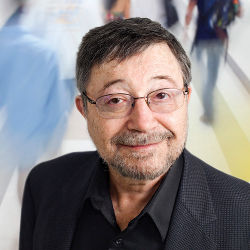
When Judea Pearl spoke about reasoning with probability at the first conference on Uncertainty in Artificial Intelligence in Los Angeles in 1985, the attendees who shared his outlook were seen as being outside the mainstream of artificial intelligence, recalls Eric Horvitz, distinguished researcher at Microsoft Research. But Pearl, winner of the 2011 ACM A.M. Turing Award, turned out to be one of the leaders of a revolution that "literally has changed the very nature of the discipline of artificial intelligence and computer science more generally," says Horvitz. (An interview with Pearl, "A Sure Thing," appears on p. 136.)
In the early 1980s, expert systems were based on sets of rules, but such reasoning systems were brittle, says Pearl, and when they provided an incorrect answer, it was not easy to figure out which of the rules was the culprit. Pearl felt strongly that humans reasoned using a probabilistic engine in their minds, but probability had fallen out of favor because applying a standard probability distribution to the number of variables involved made it exponentially complex. Yet probability was not too complex for humans. "If we do it simply," says Pearl, "computers ought to be able to do it simply, which means there ought to be a practical approximation."
Taking a cue from psychological theories of how children learn to read, Pearl developed Bayesian networks, graphical models of how beliefs can propagate in response to new observations. The algorithms he developed combined graph theory and probability theory to make the system simple enough that computers could reason probabilistically. "He basically used graph theory to characterize how you could represent conditional independence," says Joseph Halpern, a professor of computer science at Cornell University.
"When you see a phenomenon exhibited by humans, it must be that computers are able to simulate it."
However, Pearl soon believed that humans do not have a "probability engine" in their minds, but instead reason based on an understanding of cause and effect. That leads to the ability to ask the question "What if?" If you do A, the result should be B, and you can consider what the likelihood of that outcome is. "We have a causal engine in our minds, and we decorate it with probability," he says. "This is how scientists store scientific knowledge. What leads to what?"
Also, causal reasoning provides the ability to reason about counterfactuals. If there had not been A, what would have happened, which gives the ability to ask why. If you take an aspirin and you get a stomachache, you can decide that you should not have taken it. "You go back and say, ‘I would have been better off had I not done what I did,’" he explains.
Philosophers have pondered causality for hundreds of years, Halpern says, and everyone from epidemiologists to lawyers worries about it. But when Pearl developed ways of representing it mathematically, he changed the discussion. "I think it’s fair to say he reinvigorated the field of causality," says Halpern, who collaborated with him on a study of cause and explanations. "It was sort of a new way of looking at things."
Pearl’s work has implications well beyond computer science, in areas such as economics, epidemiology, and disease diagnosis. It is also contributing to areas of computing such as machine learning and natural language processing.
If a machine were to reason causally, making decisions about desired effects, it might have the illusion of free will, Pearl argues, suggesting that our own sense of choice may also be a useful illusion. "Imagine we have robots that communicate as if they had free will, blaming each other, praising each other, saying that you could have done better," he says. "We’re going to learn quite a lot about ourselves if we manage to get a robot community to communicate in this manner." And it could prove very useful to give robots this sensation of agency. "I feel if evolution equipped us with this illusion, it has some merit," says Pearl.
He urges computer scientists to be undaunted when they are told that a machine cannot emulate a human ability. "Don’t take no for an answer. When you see a phenomenon exhibited by humans, it must be that computers are able to simulate it," he says. "We may not reach human level in computers, it may be just an aspiration, but aspiration leads to positive outcomes."
Pearl has not yet decided what to do with the Turing Award’s $250,000 prize, but says he would like to devote part of the money to overcoming skepticism about his theories in some conservative scientific circles. Or he might provide a prize for students who vie against conventional wisdom, he says, "some sort of incentive to get young people to circumvent their professors."



Join the Discussion (0)
Become a Member or Sign In to Post a Comment